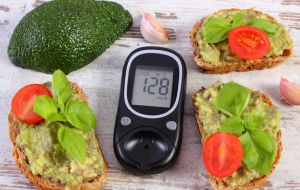Type 1 Diabetes
Health experts don’t yet know the best ways to reduce type 1 diabetes risk, but they do note that risk can run in families. Your child may be at higher than average risk if you or anyone in your family has type 1 diabetes or an autoimmune condition such as celiac disease or rheumatoid arthritis. Other risk factors include:
- Genetics. The presence of certain genes can indicate increased type 1 diabetes risk. Having a first-degree relative (parent or sibling) with type 1 diabetes may increase the risk of developing the disease 15-fold.1 Therefore, the presence of type 1 diabetes in one family member may mean other family members should be tested for type 1 diabetes risk factors; however, this testing may not be available at present without participating in a research study.2
- Low vitamin D levels. Not getting enough vitamin D during infancy and childhood may increase risk.
- Omega-3 fats. Lack of omega-3 fats in the pregnant mother’s and baby’s diets may increase risk.
- Timing of adding cereals. Introduction of cereal grains, such as rice—typically a first solid food—into a baby’s diet prior to three months or after seven months may increase risk.
- Cow’s milk (dairy) products. There is some evidence that early introduction of milk and other dairy into a baby’s diet may increase type 1 diabetes risk, especially in genetically susceptible infants.
- Geography. Risk appears to increase with distance from the equator. For example, rates of the disease are significantly higher in North America and northern Europe than in countries near the equator.
- Cold weather. Type 1 diabetes develops more often in winter than summer and is more common in places with cold climates.3
- Pregnancy and birth factors. Preeclampsia (defined as high blood pressure and excess protein in the mother’s urine), as well as jaundice in the infant at birth, may increase risk.
- Respiratory infections. Newborns who experience respiratory infections just after birth may have an increased type 1 diabetes risk.
- Maternal age. Children of younger mothers, especially those under age 25 at the time of birth, may be at increased risk for developing type 1 diabetes.
You can’t change your child’s genetics, and it’s unlikely you’ll be moving specifically to address the potential health risk associated with geography, but if you have or your baby has other risk factors for type 1 diabetes, talk to your pediatrician about steps you can take to potentially minimize the chances that your little one later develops the disease.
Our experts recommend the following tips to support your health when managing diabetes symptoms:
- Dial in your diet. Certain foods and nutrients may improve blood sugar control in people with type 1 diabetes. Olive oil and fiber may provide benefits. Select the Eating Right tab for more information. Monitoring carbohydrate intake, whether by carbohydrate counting or experience-based estimation, remains a key strategy in achieving glycemic control 4 because dietary carbohydrates have a direct effect on glucose levels after eating. Carbohydrate intake from vegetables, fruits, whole grains, legumes, and dairy products should be prioritized over intake from other carbohydrate sources.5 Provided that one controls carbohydrate intake, however, the evidence suggests that several different macronutrient distributions/eating patterns may lead to improvements in glycemic and/or CVD risk factors.
- Work with an expert. Nutrition therapy delivered by a registered dietitian (RD) is recommended for all people with type 1 diabetes; it should begin at diagnosis or at first referral for medical nutrition therapy (MNT), should be comprised of three to four encounters lasting 45–90 minutes, and should be completed within three to six months. At least one follow-up encounter is recommended annually to reinforce lifestyle changes and to evaluate and monitor outcomes that indicate the need for changes in MNT or medication(s); an RD should determine whether additional MNT sessions are needed.6
- Inquire about insulin. Insulin is a mainstay of type 1 diabetes management. The body does not make this vital hormone at all in people with the condition. But there are many types of insulin, which can be combined in different ways to best manage blood sugar levels. Work with your healthcare provider to find the right options for your lifestyle. Select Medications, above, for more information.
- Get pumped. In general, intensive management using constant glucose monitoring (CGM) should be strongly encouraged, with active patient/family participation enhancing successful outcomes.7 CGM can be accomplished with or without an insulin pump, which is a device that delivers rapid- or short-acting insulin 24 hours a day through a catheter placed under the skin. If an insulin pump is being utilized, CGM typically is integrated into the pump function. If a pump is not being used, CGM can be accomplished with a tiny sensor inserted under the skin to check glucose levels in tissue fluid. The sensor stays in place for several days to a week, and then must be replaced.
- Focus on the numbers. As part of a comprehensive intervention, self-monitoring of blood glucose (SMBG) generally, of which CGM is one technique, is a crucial component of effective therapy for type 1 diabetes, because SMBG results are useful in preventing hypoglycemia, adjusting medications, and understanding the impact of appropriate nutrition therapies and physical activity. More frequent SMBG is correlated with lower A1C levels.8
- Track with accuracy. Finding the right tools to track your blood glucose is important. Learn all you can about the features and costs of various glucose monitors. It may be worth spending a little more if you like extra features, such as an option to download your results to a computer. Select Personal Care, above, for more ideas on tools for a healthier life.
- Visit the vitamin aisle. Certain dietary supplements, such as magnesium, chromium, and alpha-lipoic acid, may improve blood sugar management or lessen frequency and severity of diabetes complications. Select Vitamins, above, for more information.
Copyright © 2024 TraceGains, Inc. All rights reserved.
Learn more about TraceGains, the company.
The information presented by TraceGains is for informational purposes only. It is based on scientific studies (human, animal, or in vitro), clinical experience, or traditional usage as cited in each article. The results reported may not necessarily occur in all individuals. Self-treatment is not recommended for life-threatening conditions that require medical treatment under a doctor's care. For many of the conditions discussed, treatment with prescription or over the counter medication is also available. Consult your doctor, practitioner, and/or pharmacist for any health problem and before using any supplements or before making any changes in prescribed medications. Information expires December 2024.















